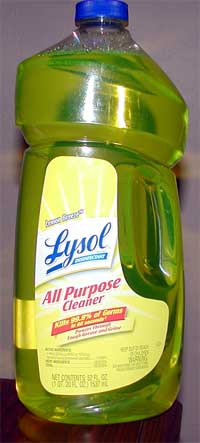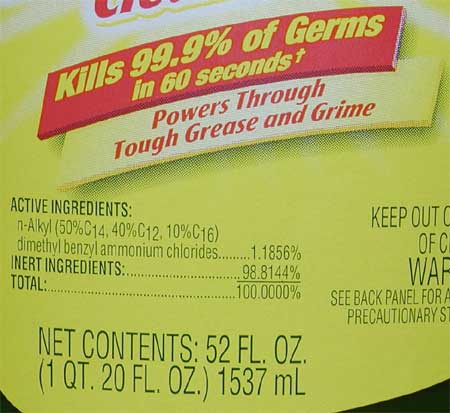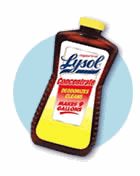
*Lysol Questions From The Board*
From The Board Kwll Posted:
I know we went over this somewhat, but I still had some questions about which Lysol product is the one we need to be stocking up on.
The one I've been buying the 52 ounce bottles of "Lysol All Purpose Cleaner" because it actually says on the label, "Kills 99.9% of Germs in 60 seconds*" whereas the other bottles of Lysol do not.

I've been wanting to buy the Lysol concentrate because it's much smaller and much cheaper per gallon. But, it doesn't say anything about killing germs, and it doesn't list its ingredients. So, I looked it up on the web and this is what I found.
The Lysol All Purpose Cleaner (LAPC) contains the following active ingredient:
Alkyl(C12-16)dimethylbenzylammonium chloride 1.19%

The Lysol Concentrate (LC) contains the following active ingredients:
Ethanol/SD Alcohol 40 1-3%
Isopropyl alcohol 1-2%
p-Chloro-o-benzylphenol 5-6%
Potassium hydroxide 3-4%
There is clearly a difference. Not being a chemist, but wanting to know if the LC was a disinfectant, I went to the Lysol website and found that the LC is advertised mostly as a "deodorizer" and secondly as a "sanitizer." The LAPC is advertised more as for disinfecting and killing germs:
http://www.lysol.com/solutionsfinder.shtml
Though, this really didn't give me a clear understanding of whether or not the LC will work for our purposes.
Also on the above page is the Lysol All Purpose Cleaner Trigger (LAPCT) that is advertised to kill 99.9% of germs in 30 seconds, half the time as the LAPC. (One caveat is that all of these germ-killing times are for hard, non-porous surfaces)
The ingredients for the LAPCT is:
Alkyl (C12-C18) dimethyl benzyl ammonium chloride
0.08%
Alkyl(C12-16)dimethylbenzylammonium chloride 0.02%
To me, it looks like the LC is not good enough for our purposes for the decontaminaton and neutralizing of infections diseases. But, as already pointed out, I'm no chemist, so I could be wrong here.
Anyone know which type, or chemical makeup, of Lysol the CDC uses?
I Googled for *Lysol decontamination* but all i found were references to Lysol in general, not a specific Lysol product.
Anyone have any better info that what I'm finding?
Haumana Responded:
You want the Lysol Concentrate. It's the p-Chloro-o-benzylphenol 5-6% that is that active agent you're looking for. I use the CDC's 2002 Lab Accident Response Protocol Guidelines as a reference.
Resqtech Responded:
For those interested:
http://www.bt.cdc.gov/agent/smallpox/vaccination/qa_docs/spillresponse.pdf
Sentinel Asked:
Is this concentrate the same chemical p-Chloro-o-benzylphenol 5-6%

Haumana Responded:
Four Most Commonly Recommended DISINFECTANTS for Use in CDC/ATSDR Infectious Disease Laboratories
NOTE: Any mention of trade names is for identification purposes only and is not intended as an endorsement. Proprietary disinfectant products should be used in accordance with the manufacturer’s instructions for concentration, contact time, or other conditions of use.
1. CHLORINE COMPOUNDS. Powerful germicides with a wide spectrum of activity, lack of toxic residuals, and low cost. Like other halogens, they are highly reactive with organic matter and must be used either on a clean surface or in high concentrations. They are corrosive to metals, and rinsing is necessary when using concentrated solutions. Sodium hypochlorite solutions possess intermediate-level disinfectant properties, including some sporicidal activity against bacterial spores such as Bacillus anthracis. Commonly available sources of sodium hypochlorite solutions are proprietary products, household chlorine bleach, and reagent grade chemical. Sodium hypochlorite solutions are excellent laboratory disinfectants for incubators, tabletops, and laboratory spills. When using proprietary versions of sodium hypochlorite solutions, please read and follow label instructions for use carefully. Proprietary products may be more highly concentrated compared to household chlorine bleach, which in the U.S. is typically available at a concentration of 5.25% free available chlorine. NOTE: 5.25% chlorine is equivalent to 52,500 parts per million (ppm). If household chlorine bleach is used, two working solutions are generally recommended: 5000 - 6000 ppm for initial decontamination of organic spill material, and 500 - 600 ppm for disinfection of cleaned surfaces. The directions for preperation of these solutions are listed on the following page. These dilutions are adequate for decontaminating surfaces with blood or other potentially infectious material. For maximum potency, the working solutions should be prepared fresh at the time of use or daily as needed. Coxiella burnetii, the causative agent of Q fever, is not inactivated by 5% Clorox or Alcide (10:1:1) after 24 hours of contact time at room temperature.
Commonly Recommended Chlorine Disinfectant Solutions for Use in CDC/ATSDR Infectious Disease Laboratories:
To prepare a 5000 - 6000 ppm solution from a 5.25% bleach solution:
English: Add 1¼ c. (12.8 oz.) bleach to 1 gal. of water (128 oz.), or ¾ c. (6 oz.) bleach to 2 qts. of water (64 oz.), or 3 oz. bleach to 1 qt. of water (32 oz.).
Metric: Add 500 mL bleach to 4500 mL of water, or 50 mL bleach to 450 mL of water, or 5 mL bleach to 45 mL of water.
To prepare a 500 - 600 ppm solution from a 5.25% bleach solution:
English: Add ¼ c. (2 oz.) bleach to 1 gal. (128 oz.) of water
Metric: Add 50 mL bleach to 4950 mL of water, or 5 mL bleach to 495 mL of water.
2. ALCOHOLS. In concentrations of 70 to 90%, alcohols are an excellent disinfectant of intermediate germicidal activity. Isopropyl alcohol is widely used as an antiseptic and for rapid decontamination of small objects. It does not inactivate picornaviruses, whereas ethyl alcohol does. Alcohols can form flammable mixtures with air and should be used with care for surface disinfection in closed areas, such as biological safety cabinets. For emergency disinfection of certain items, immersion in 75-90% ethyl alcohol for 15 minutes is recommended. Coxiella burnetii is inactivated by either 70% ethyl alcohol or 5% chloroform after a contact time of 30 minutes.
3. PHENOLIC COMPOUNDS. These compounds, derived from coal tar, were first used as wound dressings, but today have a wide use as general disinfectants. Examples are ‘Lysol’ (cresol and soap solution) and ‘Stericol’ xylenol-rich cresylic acid and soap solution), both of which are active against viruses and bacteria but less active against bacterial spores. They are particularly effective for lipid-enveloped viruses. Working solutions of phenolics at pH 8 or below are most effective against microorganisms. However, treatment of Coxiella burnetii with a 5% solution of Lysol failed to inactivate after 24 hours at 250 C.
4. QUATERNARY AMMONIUM COMPOUNDS. This category of compounds has been found to be highly effective against an extremely wide range of microorganisms, including gram positive and gram negative bacteria, fungi and some viruses. Quaternary ammonium chlorides are odorless and have low oral toxicity and skin irritation at concentration of 400-500 ppm of quaternary used for disinfection. The germicidal activity of quats increases as the pH increases. Commercially available Enviro-Chem (N-akyl dimethyl benzyl and ethylbenzal ammonium chlorides) at a 5% solution will inactivate Coxiella burnetii within 30 minutes at 250C.
[Source: 2002 CDC Biological Spill Reponse Guide]
See Also Haumana's Article And see the Chemical Sheet
Message Board
www.alpharubicon.com
All materials at this site not otherwise credited are Copyright © 1996 - 2005 Trip Williams. All rights reserved. May be reproduced for personal use only. Use of any material contained herein is subject to stated terms or written permission.